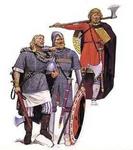 People exist at certain geographical location at some historical period; as time passed by areas of human distribution and borders of states changed. Both ethnic groups and states are not eternal: they are born and perish, develop and transform in new social communities. So Russian, Ukrainian and Byelorussian people were formed on the basis of eastern Slavonic superethnic group. People exist at certain geographical location at some historical period; as time passed by areas of human distribution and borders of states changed. Both ethnic groups and states are not eternal: they are born and perish, develop and transform in new social communities. So Russian, Ukrainian and Byelorussian people were formed on the basis of eastern Slavonic superethnic group.
Formation of people (process of ethnogeny) and formation of states have economic base closely connected with inhabitancy of people and their way of life which in its turn influenced cultural and community features of ethnic groups.
Natural cradle of eastern Slavic people of the Russian state was Eastern European plain. Its open spaces, landscapes, soil and climatic conditions, river basins determined not only the formation of dominant economic and cultural complexes, population settlements but also the formation of ethnic and state frontiers according to results of armed political conflicts and colonization processes.
To the middle of the first millenium AD there were steady economic and cultural complexes located in woods, forest-steppes and steppe zones of Eurasia; the process of ethnogeny developed actively. To VI - VII centuries the final stage of eastern slavs allocation from common pro-Slavonic unity began.
The transformation of eastern Slavic cultural and ethnic community into local independent civilization was connected with the adoption of Christianity by prince Vladimir in 988.
With adoption of Christianity eastern Slavs entered Orthodox Church which determined development of t he Russian state. Transformation of Kiev into the political, cultural and religious centre of eastern Slavic state resulted in gradual strengthening of cultural delimitation of the Kiev Russia relative the west slavic neighbours who adopted Christianity from Rome. Epoch of the Kiev Russia was the period of mainly southern orientation of eastern Slavic life. Russia was close to Byzantium because of religious and trade communications, to Bulgaria - because of common script. he Russian state. Transformation of Kiev into the political, cultural and religious centre of eastern Slavic state resulted in gradual strengthening of cultural delimitation of the Kiev Russia relative the west slavic neighbours who adopted Christianity from Rome. Epoch of the Kiev Russia was the period of mainly southern orientation of eastern Slavic life. Russia was close to Byzantium because of religious and trade communications, to Bulgaria - because of common script.
The form of government of the Ancient Russian state included three components - veche as a special form of national assembly which discussed the most important questions; royal authority with administrative, judicial and military powers; royal council which was the assembly of supreme administration representatives.
The state was multinational from its formation. On the territory of Ancient Russia lived Finno-Ugric people - Karelians, Veps, Saams. The Perm land occupied by Komi was joined at the end of XV century.
|













 History
History  Ancient Russia
Ancient Russia